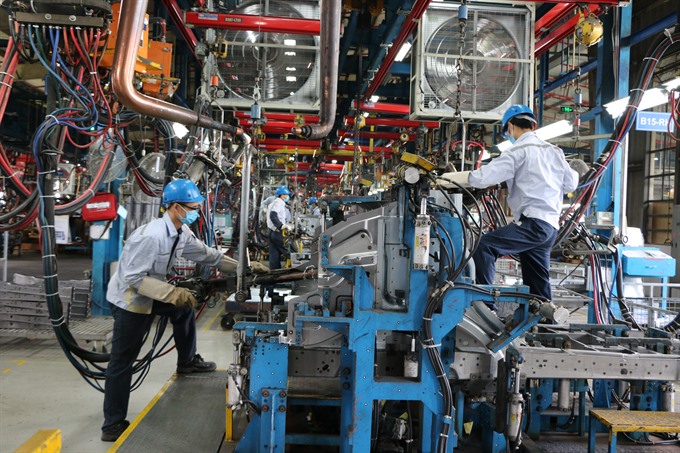 Society
Society

Vũ Đức Khâm, 43, was just coming out of anaesthesia after seven hours of having his lungs washed at the Coal and Mineral Hospital in Hà Nội.
 |
| Workers at automobile-making factory of Ford Company in Việt Nam. Mining, construction, mechanics, chemicals manufacturing and use are the sectors with the highest number of workers contracting occupational illnesses in Việt Nam. — VNS Photo Đoàn Tùng |
HÀ NỘI — Vũ Đức Khâm, 43, was just coming out of anaesthesia after seven hours of having his lungs washed at the Coal and Mineral Hospital in Hà Nội.
His lungs were found to be covered with silica after 17 years working underground as a coal miner in northern Quảng Ninh Province. He did not know he contracted silicosis until he underwent a medical check-up at the beginning of this year.
“My lung washing liquid looks dark and scary,” he said.
According to Lê Quang Chung, deputy director of the hospital, the Coal and Mineral Hospital has so far washed out the lungs of more than 2,000 people with silicosis, most of whom are workers in the coal and mineral mining sector.
“Silicosis-infected patients cannot recover perfectly from the infection as the result of pulmonary fibrosis. Without proper treatment, the disease might result in complications which reduce patients’ lifespan,” Chung said.
Exhausted with burdensome work as a bricklayer for a construction company under the Ministry of Industry and Trade, Đinh Thị Hòa, 54, living in Hà Nội’s Hai Bà Trưng District, asked for work leave in 1994.
After 19 years working under unusual weather conditions, pollution and constant changes of work locations, she suffers from respiratory symptoms, permanent muscle and bone pain, and sometimes high-blood pressure.
Most workers at the company quit their jobs at the age of 40 due to declining health, after 20 years of labour, Hoàng Thị Đường, a company worker, living in Hai Bà Trưng District’s Quỳnh Mai Ward said.
They are just a few among the workers catching diseases while working in risk-exposed environments. However, not many of them have ever heard of this referred to as “occupational disease”.
According to medical experts, an occupational disease is any chronic ailment that occurs as a result of work or occupational activity.
In Việt Nam, mining, construction, mechanics, chemicals manufacturing and use are the sectors with the highest number of workers contracting occupational illnesses, Nhân Dân (People) newspaper reported.
According to a study by the newspaper, over the past five years, 24 per cent of workers nationwide asked for sick leave, much higher than in previous years.
More than 70 per cent of miners and construction workers have their health status classified as second and third rank (with first being the highest).
So far up to 447 workers nationwide are suspected to have contracted occupational diseases that relate to asbestos, a mineral commonly used in construction, mining and industrial sectors, and is the leading “culprit” of silicosis and various cancers.
Experts predict that asbestos-related ailments will be on the rise over the coming decades as its incubation period lasts for up to 30 years. So symptoms might not develop until workers have retired.
Lack of supervision
According to the Labour Code, employers must ensure that the working environment meets standards on space, air, light and other hazardous and toxic elements. These factors need to be monitored regularly.
Nguyễn Văn Sơn, deputy head of the Institute of Occupational and Environmental Health said that a lot of firms disregard the work environment, conditions and health protection measures for workers.
According to the Health Environment Management Department under the Health Ministry, only 5 to 10 per cent of registered businesses conduct work environment assessments. The assessments found that factors related to dust, noise, toxic substances, vibration, and radioactivity far exceed safe criteria.
Lương Mai Anh, deputy head of the department, said less than 10 per cent of workers nationwide who have health insurance are offered occupational disease check-ups by their employers.
In fact, tens of thousands of Vietnamese workers have to ask for “early retirement” due to illness, without knowing that they have contracted occupational disease or enjoying health insurance benefits.
She said that nearly 29,000 workers across the country have had their health assessed and receive occupational disease pay.
“In fact, the actual number of employees who have suffered from occupational diseases could be 10 times higher than the reported figures because of the ignorance of health check-ups by many businesses,” she said.
National strategy necessary
Until 2015, Việt Nam has recognised 34 occupational diseases. According to regulations, health insurance is only paid for workers diagnosed to have contracted the listed diseases. However, over the years, many new work-related illnesses have appeared, leading to the fact that many workers who contract ailments “obviously” caused by their jobs fail to receive any insurance.
A study by the National Institute for Science, Technology and Labour Protection under the Việt Nam General Confederation of Labour (VGCL) showed that female labourers working at frozen seafood processing factories get varicose veins in their calves, as a result of standing for prolonged periods. Musculoskeletal disorders amongst shoe-makers and diseases following exposure to toxic liquid are also common among workers but they have not been added to the list.
Associate Professor Nguyễn An Lương, VGCL former vice president and incumbent president of Việt Nam Occupational Safety and Health Association said “The slow amendments to the occupational diseases list means that workers suffer from the loss of benefits in terms of insurance.”
“The International Labour Organisation, since 2010, has adopted a list of 105 occupational diseases. Compared to the 34 diseases recognised in Việt Nam, the number is too humble,” he said.
Meanwhile, diagnosis, supervision and treatment of occupational diseases in Việt Nam lack both equipment and human resources, Doctor Nguyễn Văn Sơn, deputy head of the Institute of Occupational and Environmental Health said.
There are only 63 departments and 53 clinics nationwide with over 300 doctors specialsing in treating occupational diseases.
Occupational diseases departments of central-level hospitals such as Hospital E, and Thanh Nhàn Hospital in Hà Nội are no longer operational.
Nhân Dân newspaper reported that until now, Việt Nam has not had a national data system on occupational diseases.
According to Associate Professor Nguyễn An Lương, occupational diseases place a burden on families and society but they can be avoided.
“Building a preventive strategy is the key to solving the problem. The strategy must focus on ensuring safety at the workplace, studying and adding a list of occupational diseases covered with health insurance,” he said.
Lê Hữu Nghị, deputy director of the Construction Hospital agreed with the solution, saying that a national strategy to protect workers’ health would preserve invaluable “resources” of society. — VNS




